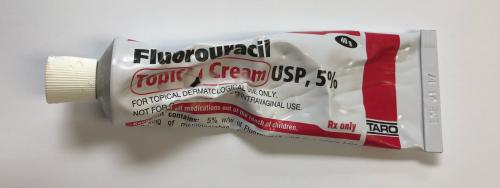For many households, pets are our best friends. For some people they are also indispensable service animals. Many show their affection by licking us. Others like to chew on things—your furniture, your shoes, your purse – anything that’s within reach. This includes medicated cream containers you apply to your skin that are stored on your nightstand or the countertop.
Sadly, the FDA has received reports involving dogs that were exposed to one type of medicated cream called fluorouracil. All the dogs died. If your medicine contains fluorouracil, immediately move it somewhere out of reach of your pets & keep them from licking your skin where you’ve applied the medicine. Why? Because fluorouracil, if ingested, can be deadly to pets.
What is fluorouracil?
Fluorouracil, also called “5-FU” or “5-fluorouracil,” is an FDA-approved chemotherapy drug commonly used to treat a wide variety of cancers in people, including some types of skin cancers & a condition called solar or actinic keratosis, which can lead to skin cancer. It’s also used to treat warts in children & occasionally in veterinary medicine to treat cancers in horses. Fluorouracil is available either as a solution for injection or as a topical cream or topical solution that’s applied on the skin. The containers of topical cream or topical solution may include the brand names Efudex, Carac, Tolak, & Fluoroplex or state “Fluorouracil.”
Why is fluorouracil important to know about if you have pets?
Pets can be exposed to fluorouracil by chewing on containers, usually tubes, of topical fluorouracil or by licking the area of your skin where you applied the medicine. FDA has not yet received any reports of fluorouracil poisoning in cats or other pets but recommends that this drug also be kept away from all pets for their safety.
Signs of fluorouracil poisoning in pets can start within 30 minutes, & include vomiting, shaking, seizures, difficulty breathing, & diarrhea. Death can happen in as little as 6 to 12 hours after a pet is exposed to fluorouracil. If your pet comes into contact with fluorouracil, seek immediate veterinary care, & bring the container of fluorouracil with you.
Many pet owners, health care providers, including dermatologists & pharmacists, & even veterinarians may be unaware of how deadly fluorouracil is to animals. Because of this, FDA asked makers of fluorouracil topical products to add new wording to the product labels that warn users about the danger to pets. For example, the new wording states, “May be fatal if your pet licks or ingests. Avoid allowing pets to contact this tube or your skin where fluorouracil has been applied. Store & dispose out of reach of pets.”
What can pet owners do to keep pets safe?
Minutes matter when it comes to fluorouracil poisoning. Immediately contact your veterinarian or local emergency veterinary hospital if your pet licks the area where you applied fluorouracil or chews the container & consumes some of the fluorouracil. Make sure the veterinarian knows your pet was exposed to fluorouracil.
You may be wondering what you can do to keep your pet safe from your fluorouracil. Simple–keep all products containing fluorouracil out of reach of your pets.
- Store the container in a closed cabinet or on a shelf the animal cannot reach.
- Dispose of empty containers in areas that are inaccessible to your pet.
- Talk to your health care provider about whether you should cover the treated area with clothing or gauze to prevent your pet from licking your skin.
For more helpful tips, visit FDA’s webpage for pet owners on how to safely store medications & our medication errors webpage, which has tips for how to avoid accidental medication exposures in pets.
How do I report a fluorouracil problem to FDA?
If your pet has a problem with fluorouracil or any other human or animal drug, please report it to FDA’s Center for Veterinary Medicine.
In the meantime, keep all drugs for people & animals stored safely & out of reach of your pet. Safely storing your fluorouracil topical products can save your pet’s life.
Source: FDA Consumer Updates

